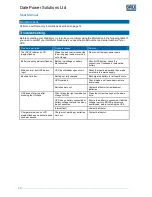
Dale Power Solutions Ltd
User Manual
8
…………………………………………………………………………………………………………
Installation
Siting considerations
Before unpacking and installing the unit, consider the following:
■ DO NOT expose the UPS to high temperatures, water ingress, flammable or corrosive gas, dust,
direct sunlight or explosives.
■ Locate the UPS indoors on a level surface as close as possible to the equipment it will be powering to
minimise cable voltage drops. Allow enough spare cable to move the UPS and access the rear and
side panels during servicing.
■ Maintain a gap of at least 20 cm between the ventilation holes/slots at the front and rear of the unit,
and walls or other equipment.
■ For maximum battery life and improved product reliability ensure cool air is available at the front of the
unit. As an approximation, battery life is halved for every 10K (10°C) rise in temperature.
■ Ensure the ambient temperature is in the range 0 to 40°C. If you need to operate the UPS above
40°C, derate the output by 2.4% per °C increase in temperature. The maximum operating
temperature is 50°C.
Wiring considerations
To ensure a safe installation please follow these instructions and the local electrical code of the area or
country in which you are installing the equipment:
■ If the UPS is to be supplied from a local transformer, ensure the transformer kVA rating is at least
50% greater than the UPS output kVA rating.
■ Use the cables provided to wire up the input and output. The cables are fitted with the appropriate
female and male connectors for input and output respectively.
■ If using external batteries, you will be supplied with a separate battery box that includes a battery
breaker, or you may be supplied with a set of battery leads and a breaker (50 A MCB single-pole).
Caution:
As a minimum you must fit a 50 A single pole MCB in the battery line. However,
you can use a double pole breaker if you prefer.
■ If supplying your own external battery, do not exceed 56 Ah. The use of higher capacity batteries is
possible with additional charging capacity. Consult your distributor for details.
■ DO NOT connect inductive loads such as motors, fluorescent lamps and photocopiers to the UPS, as
damage may occur.
■ Ensure the mains supply has over-current protection and is correctly earth.
■ When connecting a laser printer to the UPS, ensure the capacity of the UPS is equal to or greater
than the highest power rating of the laser printer plus any other loads.
Operation from a generator
As a guide we recommend that the load capacity should be less than 30% of the generator capacity, and
the generator rating should be 1.5 to 2 times the rating of the UPS, depending on the type of generator
used.
Caution:
Ensure that the neutral line from the generator is permanently connected to the
mains neutral line. Do not use an MCB or any other type of switch in this line.
Circuit breaker and cable sizes
Units are supplied with appropriately sized cables with moulded plugs and sockets at each end. E202(E)
and E203(E) units are supplied with a higher current IEC male plug as an additional wiring option. Suffix
E units are usually supplied with 10 mm
2
battery cables and a 50 A MCB battery breaker.









































